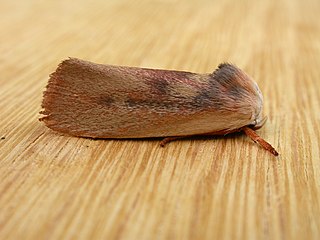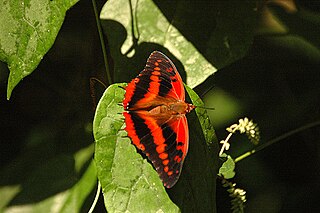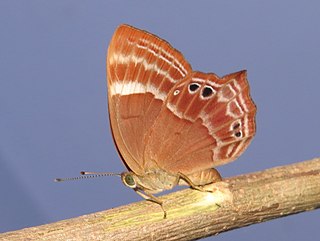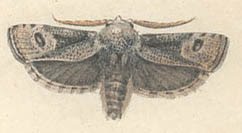Related Research Articles

Mycalesis oculus, the red-disc bushbrown, is a satyrine butterfly found in southern India. It is similar in markings to Mycalesis adolphei but distinguished by the reddish band around the large apical spots on the upper forewings.

Ixias pyrene, the yellow orange tip, is a small butterfly of the family Pieridae, that is, the yellows and whites, which is found in Sri Lanka, India and southeast Asia.

Neptis clinia, the southern sullied sailer or clear sailer, is a species of nymphalid butterfly found in South Asia and Southeast Asia.

Rapala lankana, the Malabar flash, is a species of lycaenid or blue butterfly found in South India and Sri Lanka. It was first described by Frederic Moore in 1879.

Cryptophasa rubescens is a moth of the family Xyloryctidae. It is found in Australia, where it has been recorded from New South Wales, Queensland and Victoria.

Hepalastis pumilio is a moth of the family Pterophoridae. It has worldwide tropical distribution, including Argentina, Brazil, Colombia, Costa Rica, Cuba, Ecuador, Guadeloupe, Jamaica, Mexico, Puerto Rico, Suriname, Japan, Micronesia, South Africa the Virgin Islands as well as Queensland and New Guinea.

Charaxes cynthia, the western red charaxes, is a butterfly in the family Nymphalidae. It is found in Senegal, Guinea, Sierra Leone, Liberia, Ivory Coast, Ghana, Nigeria, Cameroon, Gabon, the Republic of the Congo, the Central African Republic, the Democratic Republic of the Congo, Uganda, Angola, Sudan, Uganda, Kenya, Tanzania and Zambia. The habitat consists of primary forests.

Abisara bifasciata, the double-banded Judy or twospot plum Judy, is a butterfly in the family Riodinidae. It is found in Asia.
Oreta pulchripes is a moth in the family Drepanidae. It was described by Arthur Gardiner Butler in 1877. It is found in China (Jilin), Japan, south-eastern Russia and Korea.
Gogana abnormalis is a moth in the family Drepanidae first described by Warren in 1897. It is found on Borneo, Sumatra and Peninsular Malaysia.
Poloma angulata is a moth in the family Eupterotidae. It was described by Francis Walker in 1855. It is found in South Africa.
Cryptophasa tetrazona is a moth in the family Xyloryctidae. It was described by Oswald Bertram Lower in 1901. It is found in Australia, where it has been recorded from New South Wales, Queensland, Victoria and Western Australia.
Cryptophasa platypedimela is a moth in the family Xyloryctidae. It was described by Oswald Bertram Lower in 1894. It is found in Australia, where it has been recorded from Queensland.
Cryptophasa isoneura is a moth in the family Xyloryctidae. It was described by Oswald Bertram Lower in 1902. It is found in Australia, where it has been recorded from Queensland, South Australia and Victoria.

Cryptophasa irrorata is a moth in the family Xyloryctidae. It was described by John Lewin in 1805. It is found in Papua New Guinea and Australia, where it has been recorded from the Australian Capital Territory, New South Wales, Queensland and South Australia.
Cryptophasa phycidoides is a moth in the family Xyloryctidae. It was described by Thomas Pennington Lucas in 1901. It is found in Australia, where it has been recorded from New South Wales and Queensland.
Cryptophasa molaris is a moth in the family Xyloryctidae. It was described by Thomas Pennington Lucas in 1900. It is found in Australia, where it has been recorded from New South Wales and Queensland.
Cryptophasa nubila is a moth in the family Xyloryctidae. It was described by Thomas Pennington Lucas in 1894. It is found in Australia, where it has been recorded from New South Wales and Queensland.
Gonionota ioleuca is a moth in the family Depressariidae. It was described by Edward Meyrick in 1912. It is found in Argentina.
Gonionota uberrima is a moth in the family Depressariidae. It was described by Edward Meyrick in 1914. It is found in Peru.
References
- ↑ Savela, Markku. "Cryptophasa Lewin, 1805". Lepidoptera and Some Other Life Forms. Retrieved October 11, 2017.
- ↑ Lepidoptera Larvae of Australia
- ↑ Proceedings of the Zoological Society of London 1877 (3): 475
| This article on a moth of the family Xyloryctidae is a stub. You can help Wikipedia by expanding it. |